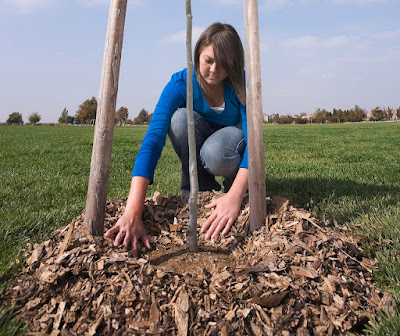
SacTree hosts event Saturday morning at business park

|
|
Tree planting is an important part of Sacramento
Tree Foundation activities, and all ages are welcome.
(Photo courtesy Sacramento Tree Foundation)
|
It’s time for the City of Trees to embrace the River District!
Volunteers are needed by the Sacramento Tree Foundation to plant trees Saturday morning in the River District Business Park.
The River District is northwest of downtown Sacramento, extending from the confluence of the American and Sacramento rivers to the Highway 160 area. The tree planting site will bring young trees to one of the Sacramento’s fastest-changing areas.
Volunteers will meet at 1103 N. B St. at 8:45 a.m. Saturday, Jan. 22, with work wrapping up at noon.
“Join us as we plant trees in front of one of businesses in the River District,” says SacTree. “Planting trees … helps create more welcoming communities, assists in reducing businesses energy bills, attracts more shoppers, and encourages everyone to get outside – helping make these communities more livable and lovable!”
Registration is free, but volunteers need to register in advance. Directions and other information will be sent via email before Saturday morning. Sign up here: https://sactree.org/event/river-district-business-tree-planting/
Volunteers of all ages will be welcome; participants under age 16 must be accompanied by an adult. SacTree in particular hopes to attract people who live or work in the River District.
Close-toed shoes are required. Long sleeves and pants are recommended as well as gloves. As for pandemic protocols, attendees should wear face masks and stay socially distanced while working. No proof of vaccination is needed.
“We provide all the necessary tools and supplies to care for trees,” says SacTree. “Participants will receive a short, hands-on training on site. After learning the tools and techniques, participants will split up into groups and begin planting trees.”
January is a great time to plant trees in Sacramento. Volunteers also will learn the techniques they need to plant trees at their own homes.
Questions? Contact Kimmy Boyle, River District Project Coordinator, at kimmy@sactree.org or 916-214-9682.
Details: www.sactree.org .
Comments
0 comments have been posted.Sacramento Digs Gardening to your inbox.
Food in My Back Yard Series
May 6: Maintain soil moisture with mulch for garden success
April 29: What's (already) wrong with my tomato plants?
April 22: Should you stock up on fertilizer? (Yes!)
April 15: Grow culinary herbs in containers
April 8: When to plant summer vegetables
April 1: Don't be fooled by these garden myths
March 25: Fertilizer tips: How to 'feed' your vegetables for healthy growth
March 18: Time to give vegetable seedlings some more space
March 11: Ways to win the fight against weeds
March 4: Potatoes from the garden
Feb. 25: Plant a fruit tree now -- for later
Feb. 18: How to squeeze more food into less space
Feb. 11: When to plant? Consider staggering your transplants
Feb. 4: Starting in seed starting
Sites We Like
Garden Checklist for week of May 11
Make the most of the lower temperatures early in the week. We’ll be back in the 80s by Thursday.
* Plant, plant, plant! It’s prime planting season in the Sacramento area. Time to set out those tomato transplants along with peppers and eggplants. Pinch off any flowers on new transplants to make them concentrate on establishing roots instead of setting premature fruit.
* Direct-seed melons, cucumbers, summer squash, corn, radishes, pumpkins and annual herbs such as basil.
* Harvest cabbage, lettuce, peas and green onions.
* In the flower garden, direct-seed sunflowers, cosmos, salvia, zinnias, marigolds, celosia and asters. (You also can transplant seedlings for many of the same flowers.)
* Plant dahlia tubers.
* Transplant petunias, marigolds and perennial flowers such as astilbe, columbine, coneflowers, coreopsis, dahlias, rudbeckia and verbena.
* Keep an eye out for slugs, snails, earwigs and aphids that want to dine on tender new growth.
* Feed summer bloomers with a balanced fertilizer.
* For continued bloom, cut off spent flowers on roses as well as other flowering plants.
* Add mulch to the garden to maintain moisture. Mulch also cuts down on weeds. But don’t let it mound around the stems or trunks of trees or shrubs. Leave about a 6-inch-to-1-foot circle to avoid crown rot or other problems.
* Remember to weed! Pull those nasties before they set seed.
* Water early in the day and keep seedlings evenly moist.